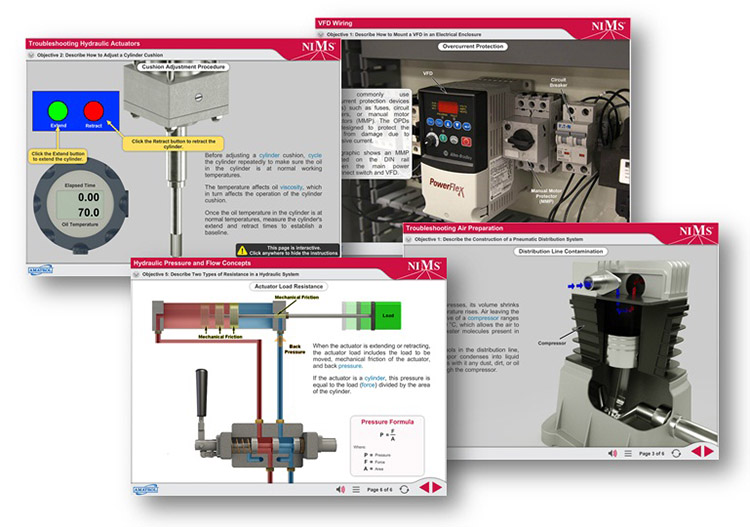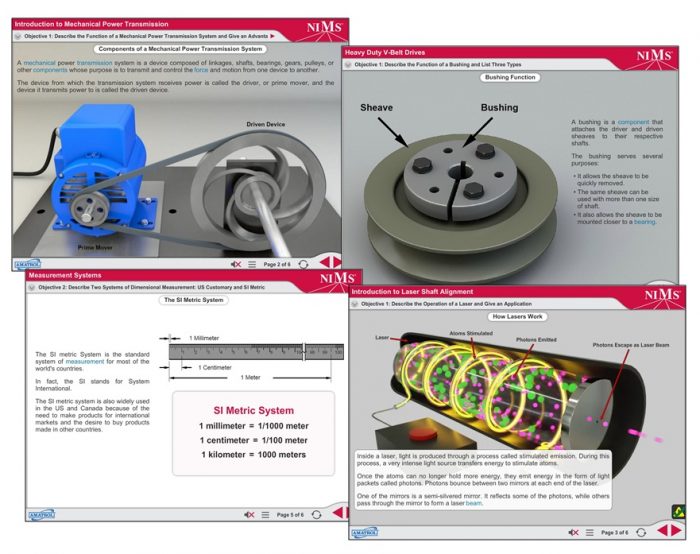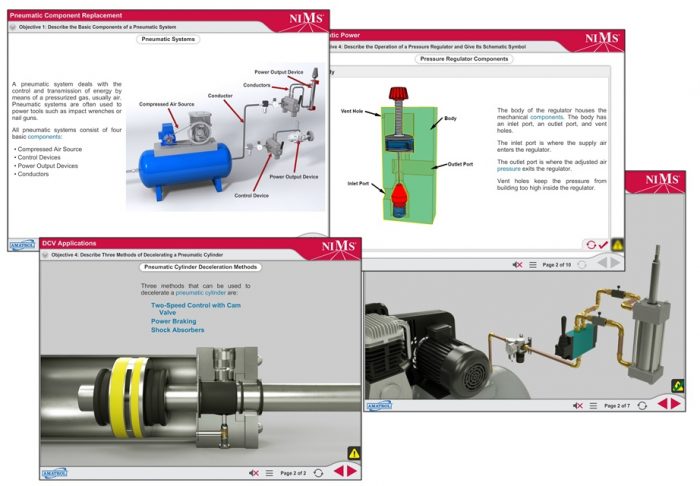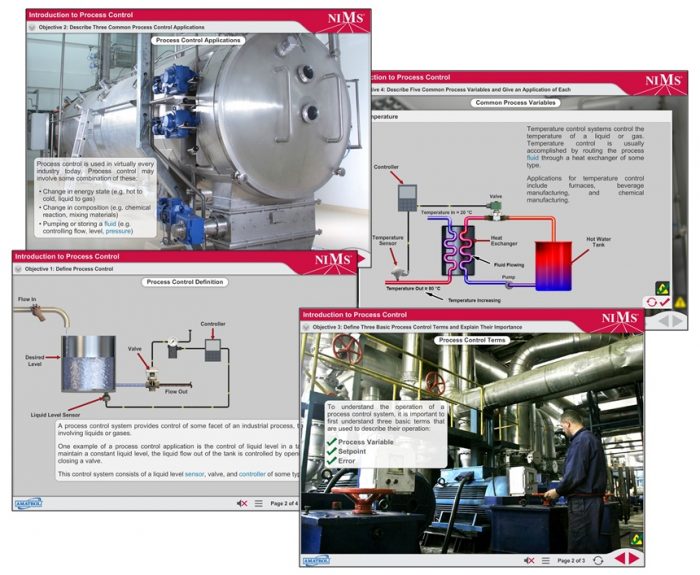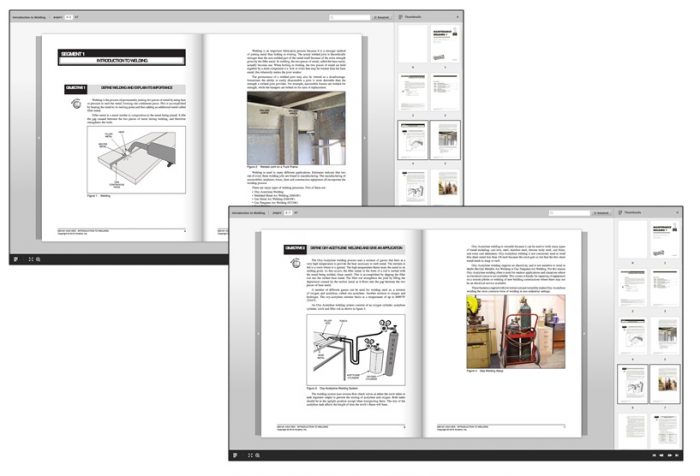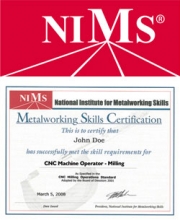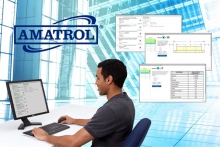NIMS Industrial Technology Maintenance (ITM)
NIMS is widely recognized for the qualified employees produced through their certification programs and Amatrol is the world’s leader in skills-based interactive technical learning. Amatrol’s hands-on, skills-focused interactive technical training includes an on-the-job training guide to aid businesses in accommodating NIMS’ credentials to real-world training experiences. These credentials were created to fill the growing number of unfilled jobs in industrial maintenance with individuals having proven skillsets.
Stackable Credentials
Learn and Earn at the Same Time!
The ITM certification features nine stackable certifications, so students can attain their certificate in any of the 9 Duty Areas, such as Maintenance Operations, and use it to find a job while they complete the other eight certifications to earn the full Industrial Technology Maintenance credential.
NIMS ITM Certifications are available in each of the following duty areas:
Maintenance OperationsDuty Area 2
Basic Mechanical SystemsDuty Area 3
Basic Hydraulic SystemsDuty Area 4
Basic Pneumatic SystemsDuty Area 5
Electrical SystemsDuty Area 6
Electronic Control SystemsDuty Area 7
Process Control SystemsDuty Area 8
Maintenance WeldingDuty Area 9
Maintenance Piping
- Duty Area 1: Maintenance Operations
- Mechanical Fabrication (950-MPF1)
- Rigging 1 (950-RGB1)
- Rigging 2 (95-RGB2)
- Duty Area 2: Basic Mechanical Systems
- Basic Measurement (990-MES1 or 950-MES1)
- Mechanical Drives 1 (950-ME1 or 990-ME1)
- Mechanical Drives 2 (95-ME2 or 99-ME2)
- Laser Alignment (95-ME2A)
- Duty Area 3: Basic Hydraulic Systems
- Basic Hydraulics (85-BH)
- Intermediate Hydraulics (85-IH)
- Hydraulic Troubleshooting (950-HTB1 or 950-HT1)
- Hydraulic Maintenance (950-HM1)
- Duty Area 4: Basic Pneumatic Systems
- Pneumatic Systems (990-PN1 or 85-BP)
- Intermediate Pneumatics (85-IP or 990-PN1)
- Pneumatic Troubleshooting (990-PTB1 or 950-PT1)
- Duty Area 5: Electrical Systems
- AC/DC Electricity (T7017A or 990-ACDC1)
- Motor Control (990-MC1 or 85-MT5)
- Rotating Machines (85-MT2)
- AC/DC Motor Troubleshooting (95-MT2E)
- Industrial Wiring Systems (850-MT6B_AL and 850-MT6B_BL)
- Soldering (85-MT6BB_AL and 85-MT6BB_BL)
- Electronic Sensors (990-SN1 or 85-SN1)
- Electro-Fluid Power (85-EF)
- Duty Area 6: Electronic Control Systems
- Power & Control Electronics (990-ELE1)
- PLC Troubleshooting (990-PAB53F or 890-PECB with 890-AB5500)
- VFD/PLC Installation (85-MT6BA_AL and 85-MT6BA_BL)
- AC Variable Frequency Drive Troubleshooting (990-DRV1F or MT5-C)
- Duty Area 7: Process Control Systems
- Process Control (T5552F)
- Duty Area 8: Maintenance Welding
- Welding Technology (
 950-WT1)
950-WT1) - Duty Area 9: Maintenance Piping
- Piping Systems (950-PS1)
NIMS ITM Certifications
Duty Area 1: Maintenance Operations
This duty area covers: adhering to safety, health, and environmental rules and regulations; operating and monitoring a machine; interpreting machine operation and maintenance documentation and technical drawings; performing machine maintenance procedures, preventative maintenance, and predictive maintenance; selecting and safely using of proper hand tool for a task; moving, handling, and storing materials and equipment; and selecting systems troubleshooting methods.
Maintenance Operations (M50111)
This course covers machine operation, machine monitoring and documentation, troubleshooting techniques, and total productive maintenance (TPM). Examples of topics within this course include: the function of a Basic Human Machine Interface (HMI); how to issue, interpret, and resolve a maintenance work order; the types of fluid power test instruments and their applications; and methods of eliminating breakdown losses.
Mechanical Component Maintenance (M50112)
This course covers: bolt and machine screw installation, basic component, precision component, and non-threaded component assembly; clamping and locking devices; power assembly; and component contamination and handling. Examples of topics include categories of torque-controlled tools, using a C-clamp to hold parts during assembly, the types of key fasteners, inspecting components for contamination, and using a wash station to clean a part.
Mechanical Print Reading (M50113)
This course covers mechanical print reading, assembly drawings, and basic part and precision dimensioning. Examples of topics include methods used to visualize the views of an object based on third-angle projection, interpreting a drawing scale, the functions of a threaded fastener, and how to place a datum feature symbol on a drawing.
Rigging Techniques (E50114)
This course covers rigging concepts, lifting devices, and wire rope and chain slings. Examples of topics include determining the center of gravity for a symmetrical load, operating an endless chain hoist, factors that affect the rated load of a hitch, assembling and lifting a load using a two-leg wire rope bridle sling and shackles, and assembling and lifting a load using a chain sling.
Rigging Techniques 2 (E50115)
This course covers synthetic slings, equipment movement, and industrial cranes. Examples of topics include assembling and lifting a load using a synthetic sling, operating various types of jacks, using roller bars and dollies to move a load, and operating an industrial crane.
Industrial Safety (M50101)
This course covers safety organization, personal protective equipment, HAZCOM, confined spaces, electrical safety, fire safety, accident response, workplace ergonomics, and maintenance organization. Examples of topics include creating a culture of safety in the workplace, using head, eye, and ear protection personal protective equipment, explaining the importance of chemical container labeling, providing characteristics of a permit-required confined space, the function of an electrical lockout/tagout system, using a fire extinguisher, preventing bloodborne pathogen exposure, interpreting common safety markings, and visual management tools used in the workplace.
*32 eLearning Modules
Hardware Systems Available to Support Hands-On Training:
NIMS ITM Certifications
Duty Area 2: Basic Mechanical Systems
This duty area covers: adhering to mechanical power transmission safety rules; using dimensional measuring tools; installing and aligning shaft couplings, belt drives, chain drives, gear drives, and pillow block bearings; identifying lubrication points, selecting lubricant, and applying lubricant to a machine; and troubleshooting power transmissions.
Dimensional Measurement (M50121)
This course covers measurement systems, calipers, micrometers, indicators, and gauging. Examples of topics include: the function and construction of a machinist’s rule, how to use a dial caliper and an outside micrometer, and using a digital indicator to measure a dimension.
Mechanical Drives 1 (M50122)
This course covers: mechanical power transmission; machine installation; performance measurement; basic shaft alignment; and basic v-belt, chain, gear, and multiple shaft gear drives. Examples of topics include six rules of safe dress for working with power transmission equipment, using fasteners to attach a motor mount to a bedplate, methods of loading a mechanical drive system, methods of mounting a shaft bearing, installing and aligning a v-belt drive, operating a single-strand roller chain drive, the function of a right-angle gear drive system, and aligning a sleeve coupling.
Mechanical Drives 2 (M50123)
This course covers heavy duty v-belt drives; lubrication systems; chain, v-belt, and synchronous belt drive troubleshooting; indicator shaft alignment; and coupling troubleshooting. Examples of topics include operating a multiple belt v-belt drive, how oils are specified, how chains are specified, methods of identifying belt size and type, installing and aligning an HTD belt drive system, types of coupling flexibility, and preventive maintenance steps for couplings.
Laser Shaft Alignment (M50124)
This course covers: rough alignment; laser shaft alignment installation, operation, and analysis; and soft foot correction. Examples of topics include safety rules for a laser alignment system, how to perform a rough alignment on a power transmission system, how to align two shafts using a laser alignment system, and how to determine shaft alignment tolerances in a power transmission system.
Industrial Safety (M50101)
This course covers safety organization, personal protective equipment, HAZCOM, confined spaces, electrical safety, fire safety, accident response, workplace ergonomics, and maintenance organization. Examples of topics include creating a culture of safety in the workplace, using head, eye, and ear protection personal protective equipment, explaining the importance of chemical container labeling, providing characteristics of a permit-required confined space, the function of an electrical lockout/tagout system, using a fire extinguisher, preventing bloodborne pathogen exposure, interpreting common safety markings, and visual management tools used in the workplace.
*20 eLearning Modules
Hardware Systems Available to Support Hands-On Training:
NIMS ITM Certifications
Duty Area 3: Basic Hydraulic Systems
This duty area covers: adhering to fluid power systems safety rules; interpreting basic fluid power schematics; starting up and shutting down a hydraulic system and adjusting system pressure; adjusting hydraulic actuator speed using a flow control valve; servicing hydraulic fluid and a hydraulic filter; installing hydraulic conductors and installing and testing components in a basic hydraulic circuit; and troubleshooting a basic hydraulic circuit.
Hydraulic Systems 1 (50131)
This course covers hydraulic pumps, circuits, pressure and flow concepts and control, and sequence control. Examples of topics include: how to read a pressure gauge; the operation of a hydraulic power unit; the function of a 3-position, 4-way directional control valve; calculating the force output of a hydraulic cylinder in retraction; the advantages of a pilot-operated relief valve; the effect of actuator load changes on flow control valve operation; and the operation of a direct-acting sequence valve.
Hydraulic Systems 2 (M50132)
This course covers hydraulic directional control valve applications, hydraulic cylinder applications, hydraulic relief valve applications, hydraulic pilot-operated check valves, and hydraulic accumulators. Examples of topics include the operation of a hydraulic 4/2 cam-operated valve, how to calculate the extend speed of a cylinder in regeneration, the operation of a remote-controlled relief valve circuit, the function of a prefill valve, and how to pre-charge a gas-loaded accumulator.
Hydraulics Troubleshooting 1 (M50133)
This course covers troubleshooting hydraulic pumps, actuators, valves on a component level and overall hydraulic systems. Examples of topics include methods of testing a hydraulic component, causes of pseudo-cavitation, how to adjust a cylinder cushion, inspecting and troubleshooting a check valve, symptoms of relief valve failure, and the construction of a troubleshooting flowchart.
Hydraulics Maintenance 1 (M50134)
This course covers the maintenance of hydraulic filters and fluids and the replacement of fittings, seals, hydraulic hoses, steel tubing, and other hydraulic components. Examples of topics include the ISO 4406 contamination code, the proper fluid to use in a hydraulic system based on manufacturer’s documentation, the operation of a straight thread O-ring fitting, installing a hydraulic hose using brackets and clips, the function of thread sealant in a hydraulic system, and how to replace a subplate-mounted valve in a hydraulic system.
Industrial Safety (M50101)
This course covers safety organization, personal protective equipment, HAZCOM, confined spaces, electrical safety, fire safety, accident response, workplace ergonomics, and maintenance organization. Examples of topics include creating a culture of safety in the workplace, using head, eye, and ear protection personal protective equipment, explaining the importance of chemical container labeling, providing characteristics of a permit-required confined space, the function of an electrical lockout/tagout system, using a fire extinguisher, preventing bloodborne pathogen exposure, interpreting common safety markings, and visual management tools used in the workplace.
*20 eLearning Modules
Hardware Systems Available to Support Hands-On Training:
NIMS ITM Certifications
Duty Area 4: Basic Pneumatic Systems
This duty area covers: adhering to fluid power systems safety rules; adjusting pneumatic system branch operating pressure using a regulator and pneumatic actuator speed using a flow control valve; servicing a pneumatic filter and pneumatic lubricator; installing pneumatic conductors; starting up and shutting down a reciprocating air compressor and adjusting operating pressure; and installing and testing components in pneumatic circuits.
Pneumatics 1 (50141)
This course covers pneumatic power, circuits, pressure and flow concepts, speed control circuits, and air compressors. Examples of topics include: basic rules for drawing pneumatic schematics; the functions of pressure regulator valves, flow control valves, and flowmeters; how directional control valves are classified; calculating the force output of a cylinder in retraction; and how to start and shut down a small reciprocating piston air compressor.
Pneumatics 2 (M50142)
This course covers directional control valve applications and air-piloted valves, pneumatic component maintenance and pneumatic conditioning, vacuum systems, and air compressors. Examples of topics include the operation of a pneumatic cam-operated DCV, types of pneumatic DCV construction, the function of a coalescing filter, the operation of a refrigeration type air dryer, methods used to produce vacuums, and how to start and shut down a small reciprocating piston air compressor.
Pneumatics Troubleshooting 1 (M50143)
This course covers troubleshooting a variety of pneumatic applications like air preparation, pneumatic actuators and valves, vacuum systems, and overall pneumatic systems. Examples of topics include methods of testing a pneumatic component, interpreting a pneumatic troubleshooting chart, describing the function of a rotary actuator, how to troubleshoot a vacuum generator, and the function and construction of a troubleshooting flowchart.
Pneumatics Maintenance 1 (M50144)
This course covers fluid circuit components, pipe thread components, and pneumatic fittings and tubing. Examples of topics include methods of connecting rubber hose to a fitting, how pipe threads are designated, how to install a bulkhead fitting, and types of pneumatic tubing.
Industrial Safety (M50101)
This course covers safety organization, personal protective equipment, HAZCOM, confined spaces, electrical safety, fire safety, accident response, workplace ergonomics, and maintenance organization. Examples of topics include creating a culture of safety in the workplace, using head, eye, and ear protection personal protective equipment, explaining the importance of chemical container labeling, providing characteristics of a permit-required confined space, the function of an electrical lockout/tagout system, using a fire extinguisher, preventing bloodborne pathogen exposure, interpreting common safety markings, and visual management tools used in the workplace.
*14 eLearning Modules
Hardware Systems Available to Support Hands-On Training:
NIMS ITM Certifications
Duty Area 5: Electrical Systems
This duty area covers: adhering to electrical power and control systems safety rules; interpreting electrical control and power schematics; adjusting limit switches and electronic sensors; measuring voltage, current, and resistance in an electrical circuit; selecting, installing, and testing fuses and circuit breakers; installing and testing AC and DC electric motors, electrical relay control components and circuits, and electro-fluid power components and circuits; testing and repairing a machine’s electrical ground; troubleshooting an electrical motor relay control circuit and a solenoid-operated fluid power relay control circuit; replacing electrical control wiring using terminal and solder attachments; and testing and replacing transformers.
AC/DC Electrical Circuits 1 (M50151)
This course covers basic electrical circuits and their applications, electrical measurements, electrical power, electromagnetism, capacitance, and transformers. Examples of topics include types of manual switch operators, types of circuit protection, how to use a voltmeter to measure voltage, the function of electromagnetic devices, the effect of a capacitor in an AC circuit, steps for solving a combination circuit, and calculating the output voltage of a transformer.
Electronic Sensors (M50152)
This course covers inductive, capacitive, magnetic reed, hall effect, and photoelectric sensors and their applications. Examples of topics include the operation of transistors used in electronic sensors, characteristics that affect capacitive proximity sensor operation, the operation of a magnetic reed switch, and how to design a relay circuit that senses a web of material./p>
Electronic Motors 1 (M50153)
This course covers DC, single phase AC, and three-phase AC induction motors, motor performance measurement, single phase AC Power, and AC motors with capacitors. Examples of topics include basic components of an electric motor, how a DC motor is wired for separately excited shunt operation, how motor torque is developed, the performance characteristics of a motor, the operation of a split-phase motor, applications for capacitors in ac circuits, and how the speed of a permanent-capacitor motor is controlled.
Electric Motor Troubleshooting 1 (M50154)
This course covers troubleshooting AC and DC motors. Examples of topics include common methods used to diagnose DC motor failures, how to use a megger to test a DC electric motor armature, common failures of DC motor field windings, how to troubleshoot a DC motor using a troubleshooting chart, common types of AC electric motor failures, and how to use a multimeter to test an AC motor’s start/run capacitor.
Electrical Motor Control Troubleshooting 1 (M50155)
This course covers manual motor starters; control transformers; basic control, reversing motor, sequence, and timer circuits; magnetic motor control; and component-level and systems-level troubleshooting. Examples of topics include: explaining why dual-voltage motors should be run on the highest available voltage; how low-voltage protection is accomplished in a manual starter; the basic components of an electrical control circuit; the operation of selector switches, float switches, and on-delay timer relays; the operation of control relays and how to test them; how to test and analyze circuit signals; and common control methods used to reverse a three-phase motor.
Electro-Fluid Power Troubleshooting 1 (M50156)
This course covers relay control, event sequencing, and time-based sequencing. Examples of topics include how to manually override a solenoid-operated directional control valve, the operation of a limit switch in an event sequencing circuit, and the function of a time-delay relay in time-driven sequencing.
Electrical System Maintenance 1 (M50157)
This course covers electrical control and electro-pneumatic control wiring, electrical panel wiring, and industrial soldering. Examples of topics include rules for drawing a ladder diagram, how to inspect and verify an electrical grounding circuit, how to connect pneumatic system control wiring, and tools used for soldering.
Industrial Safety (M50101)
This course covers safety organization, personal protective equipment, HAZCOM, confined spaces, electrical safety, fire safety, accident response, workplace ergonomics, and maintenance organization. Examples of topics include creating a culture of safety in the workplace, using head, eye, and ear protection personal protective equipment, explaining the importance of chemical container labeling, providing characteristics of a permit-required confined space, the function of an electrical lockout/tagout system, using a fire extinguisher, preventing bloodborne pathogen exposure, interpreting common safety markings, and visual management tools used in the workplace.
- 35 eLearning Modules.
Hardware Systems Available to Support Hands-On Training:
NIMS ITM Certifications
Duty Area 6: Electronic Control Systems
This duty area covers: adhering to electronic and control systems safety rules; connecting and testing a DC power supply; installing and testing a solid-state relay, analog electronic sensors, and basic PLC components; installing and operating and AC variable frequency drive; transferring programs to programmable controller using a PC; creating a basic PLC ladder-style program; and troubleshooting PLC and controlled components.
Industrial Electronics Troubleshooting 1 (M50161)
This course covers: power supplies and conditioning; solid state switches; proximity, analog thermal, analog pressure, and ultrasonic sensors; amplifier and solid state power circuits; and silicon-controlled rectifier and triac control. Examples of topics include measuring the period and frequency of an electrical waveform, the operation of a pn junction diode, testing the output of a capacitive filter, testing a bipolar junction transistor, the operation of an inductive proximity sensor, and more.
Programmable Controller Troubleshooting 1 (M50162)
This course covers HMI operation, PLC program structure and techniques, PLC programming software, PLC timer and counter Instructions, sequence control, program control instructions, math and data move instructions, and PLC component and systems troubleshooting.
AC Variable Frequency Drives 1 (M50163)
This course covers variable frequency drive operation and speed, torque, and acceleration control. Examples of topics include how motor jogging is accomplished with a variable frequency ac drive, steps that can be taken to reduce the effects of reflected wave voltage, and how a variable frequency ac drive can accelerate a motor past its rated speed.
Electronic System Maintenance 1 (M50164)
This course covers programmable logic controller (PLC) wiring and variable frequency drive (VFD) wiring. Examples of topics include how to mount a programmable controller in an enclosure; how to test and startup a PLC installation; how to wire ground, power, and motor circuits to a VFD; and how to interface a VFD with PLC discrete I/O.
Industrial Safety (M50101)
This course covers safety organization, personal protective equipment, HAZCOM, confined spaces, electrical safety, fire safety, accident response, workplace ergonomics, and maintenance organization. Examples of topics include creating a culture of safety in the workplace, using head, eye, and ear protection personal protective equipment, explaining the importance of chemical container labeling, providing characteristics of a permit-required confined space, the function of an electrical lockout/tagout system, using a fire extinguisher, preventing bloodborne pathogen exposure, interpreting common safety markings, and visual management tools used in the workplace.
- 27 eLearning Modules
Hardware Systems Available to Support Hands-On Training:
NIMS ITM Certifications
Duty Area 7: Process Control System
This duty area covers: adhering to process control systems safety rules; reading and interpreting process control documentation; calibrating and testing analog sensors and final control elements; and installing and operating a basic controller.
Process Control 1 (M50171)
This course covers: process schematics, controllers, and instrument identification; pneumatic proportional valves; liquid level transducers; on/off and closed loop level control; PID control; closed-loop flow control; and basic loop tuning. Examples of topics include how to perform a lockout/tagout on a process control system, the types of information described by an instrument tag, how to power up a Honeywell UDC 3500 controller and determine operating status, how to adjust the spring of a diaphragm actuator proportional valve, how to measure liquid level using a pressure sensor and give an application, and many more!
Industrial Safety (M50101)
This course covers safety organization, personal protective equipment, HAZCOM, confined spaces, electrical safety, fire safety, accident response, workplace ergonomics, and maintenance organization. Examples of topics include creating a culture of safety in the workplace, using head, eye, and ear protection personal protective equipment, explaining the importance of chemical container labeling, providing characteristics of a permit-required confined space, the function of an electrical lockout/tagout system, using a fire extinguisher, preventing bloodborne pathogen exposure, interpreting common safety markings, and visual management tools used in the workplace.
- 11 eLearning Modules
Hardware Systems Available to Support Hands-On Training:
NIMS ITM Certifications
Duty Area 8: Maintenance Welding
This duty area covers: adhering to welding safety rules; using an acetylene torch; explaining welding theory, equipment, and selection process; preparing parts to be welded; using a SMAW Welder to make basic welds on flat stock; inspecting welds; and using a plasma cutter to cut flat stock.
Maintenance Welding 1 (E50181)
This course covers welding preparation, basic welding, and welding analysis. Examples of topics include the operation of an angle grinder, how to install a wire spool in a GMAW welder, how to weld a lap joint in multiple positions, and how to prepare tubing for welding.
Industrial Safety (M50101)
This course covers safety organization, personal protective equipment, HAZCOM, confined spaces, electrical safety, fire safety, accident response, workplace ergonomics, and maintenance organization. Examples of topics include creating a culture of safety in the workplace, using head, eye, and ear protection personal protective equipment, explaining the importance of chemical container labeling, providing characteristics of a permit-required confined space, the function of an electrical lockout/tagout system, using a fire extinguisher, preventing bloodborne pathogen exposure, interpreting common safety markings, and visual management tools used in the workplace
- 7 eLearning Modules
Hardware Systems Available to Support Hands-On Training:
NIMS ITM Certifications
Duty Area 9: Maintenance Piping
This duty area covers: adhering to piping system safety rules; interpreting basic piping schematics; identifying and selecting correct material; measuring and preparing material; and installing piping systems.
Piping 1 (E50191)
This course covers metal piping systems and installation; plastic piping systems; metal tubing systems; hoses; and two-way, check, and Sloan valves. Examples of topics include the color code system to identify pipe function, methods of measuring a section of piping, assembling threaded plastic pipe, determining bend locations and angles, methods of attaching a fitting to a hose, the construction of two types of flanges, and maintaining a check valve system.
Industrial Safety (M50101)
This course covers safety organization, personal protective equipment, HAZCOM, confined spaces, electrical safety, fire safety, accident response, workplace ergonomics, and maintenance organization. Examples of topics include creating a culture of safety in the workplace, using head, eye, and ear protection personal protective equipment, explaining the importance of chemical container labeling, providing characteristics of a permit-required confined space, the function of an electrical lockout/tagout system, using a fire extinguisher, preventing bloodborne pathogen exposure, interpreting common safety markings, and visual management tools used in the workplace.
- 5 eLearning Modules
Hardware Systems Available to Support Hands-On Training:
More Information
To prepare individuals for the performance-based portion of the certifications, in addition to the NIMS recommended eLearning, Amatrol offers OJT manuals, Instructor's Guides, and hardware trainer/simulators. Amatrol's hardware trainers utilize industrial components to recreate industrial applications to teach the hands-on skills required to complete the NIMS certifications.

